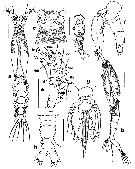
Issued from : E. Suarez-Morales, A. Goruppi, A. de Olazabal & V. Tirelli
in J. Nat. Hist., 2017, 51 (31-32) [p.1802, Fig.3].
Female (from Trieste): a-b, habitus (dorsal and lateral, respectively); c, cephalic region (ventral); d, same, preoral ventral surface and oral papilla (lateral view); e, A1 with armature (dorsal view); f, urosome with P5 (lateral); g0, same (ventral); h, same, dorsal view showing posterolateral expansion on genital double-somite.
Scale bars: 200 µm (a, b); 50 µm (c,d); 100 µm (e-h).
Nota: - Cephalothorax representing 60 % of total body length (caudal rami excluded).
- Midventral oral papilla located at 26 % of cephalothorax length.
- Pair of relatively large ocelli present, pigment cups well developed, medially conjoined, strongly pigmented ventral cup slightly larger than lateral cups.- Cephalic cuticular ornamentation including pair of unguiform scars between bases of A1.
- Urosome of 3 urosomites, together representing 17 % of total body length (caudal rami excluded), relative lengths 25 : 43 : 32 = 100.
- P5 inserted on distal 1/3 of somite showing a medial constriction.
- Genital double-somite constricted, anterior half expanded; posterior lateral margins produced into rounded processes (arrow in figure 3h)
- Anal somite about 74 % as long as genital double-somite, medially constricted, with transverse lateral ridges.
- Caudal ramus subquadrate, 1.1 times longer than wide, armed wxith 3 subequally long, sparsely setulated caudal setae.
- Ovigerous spines, relatively short, 19 % of yotal body length (caudal rami excluded); spines basally separated, relatively wide, robust, one slightly longer than the other, straight at their base and along shaft, both tapering distally.
- A1 representing about 21 % of total body length (caudal rami excluded) and 34 % of cephalothorax length; 4-segmented, suture between segments 3 and 4 present; relative length of distal antennulary segment 42 %; pattern described by Grygier & Ohtsuka (1995), setae (Roman numerals), spines (Arabic numerals).
- Pedigerous somites 2-4, together 21 % of total body length in dorsal view.
P5 basally separate, distinctly bilobate, inner (endopodal) lobe conspicuous, unarmed, arising proximally, reaching slightly beyond midlength of long outer lobe. Outer (exopodal) lobe elongated, slender, armed with 3 subequally long setae on distal position, innermost slightly longer than adjacent setae.




